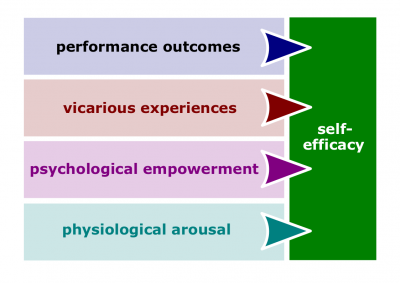Self-efficacy source
Self-efficacy source (hereinafter, the Source) is a source for self-efficacy. Those sources are also objects of the self-efficacy theory, initially developed by Albert Bandura.
Types of sources
- Performance outcome. Positive and/or negative experiences are the primary sources for self-efficacy. They influence the ability of an individual to perform a given task.
Similarly, achieving simple tasks leads to more complex objectives.If one has performed well at a task previously, they are more likely to feel competent and perform well at a related task. [...] Vice versa, previously failed tasks will result in low self-efficacy (Redmond, 2010).
- Vicarious experience (also known as vicarious modeling or social modeling). ). An identifiable model that shows the processes that accomplish a behavior. People can develop high or low self-efficacy vicariously through other people's performances.
If a person sees someone similar to them succeed, it can increase their self-efficacy. However, the opposite is also true; seeing someone similar fail can lower self-efficacy. An example of how vicarious experiences can increase self-efficacy in the work place is through mentoring programs, where an individual can be paired with someone on a similar career path who is successful at raising the individual’s self-efficacy beliefs. An example of how the opposite can be true is in a smoking cessation program where if one or two people fail to quit, another person's efficacy belief can be lowered, hence he/she may also fail to quit.A person can watch another perform and then compare their competence with the other's competence (Redmond, 2010).
- Psychological empowerment. Providing encouragement (or, vice versa, discouragement) for an individual pertaining to his or her performance or ability to perform or complete a job task, or to achieve a certain behavior. The effectiveness of verbal persuasion is directly influenced by the level of credibility; where there is more credibility there will be a greater influence. In the example above, a pep talk by a manager who has an established, respectable position would have a stronger influence than that of a newly hired manager.
- Physiological arousal. Improving physical and emotional states that refer to ensuring that an individual experiences sensations from his or her body since emotional arousals may influence his or her beliefs of efficacy.
Although this source is the least influential of the four, it is important to note that if one is more at ease with the task at hand they will feel more capable and have higher beliefs of self-efficacy.Some examples of physiological feedback are: giving a speech in front of a large group of people, making a presentation to an important client, taking an exam, etc. All of these tasks can cause agitation, anxiety, sweaty palms, and/or a racing heart. (Redmond, 2010)
